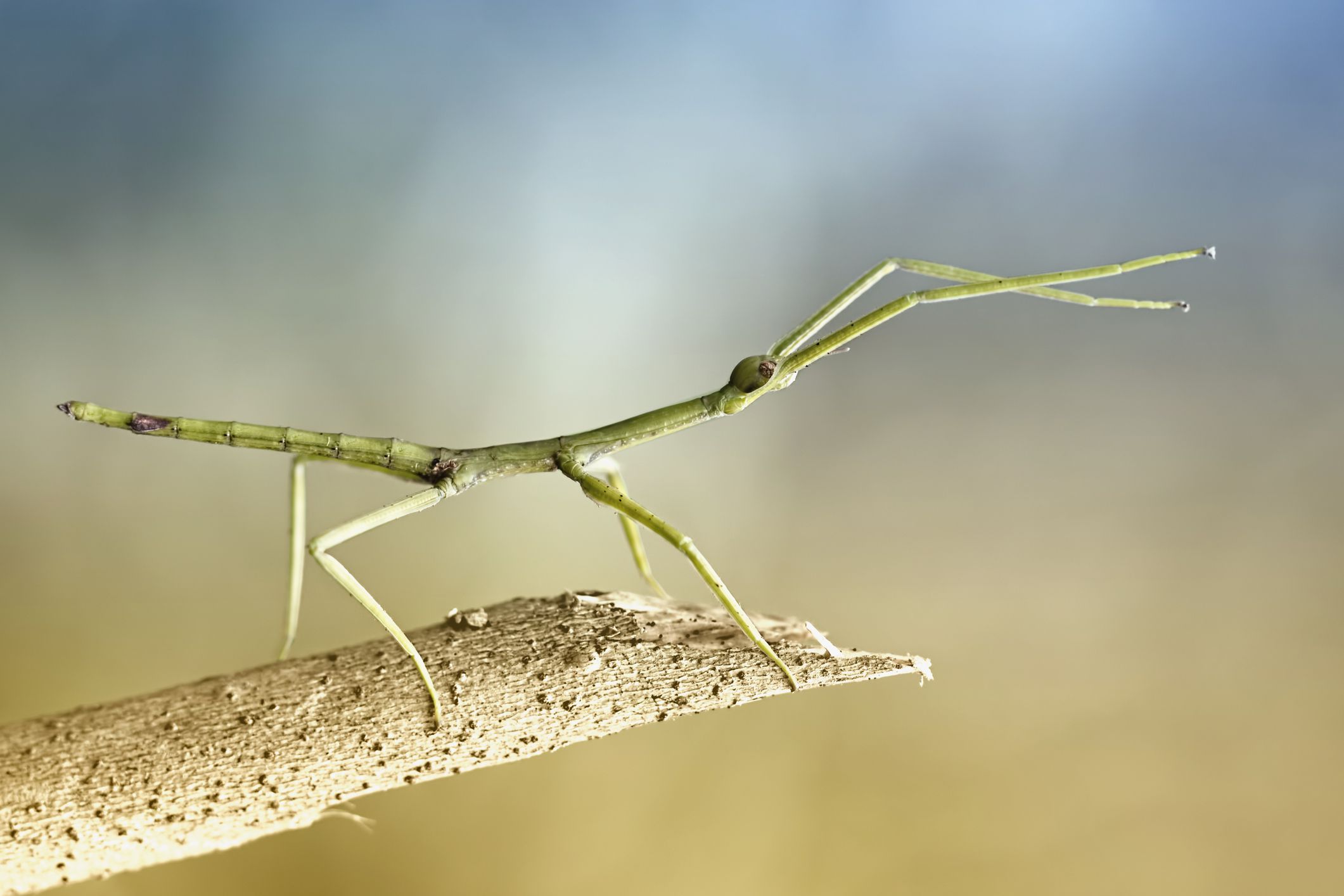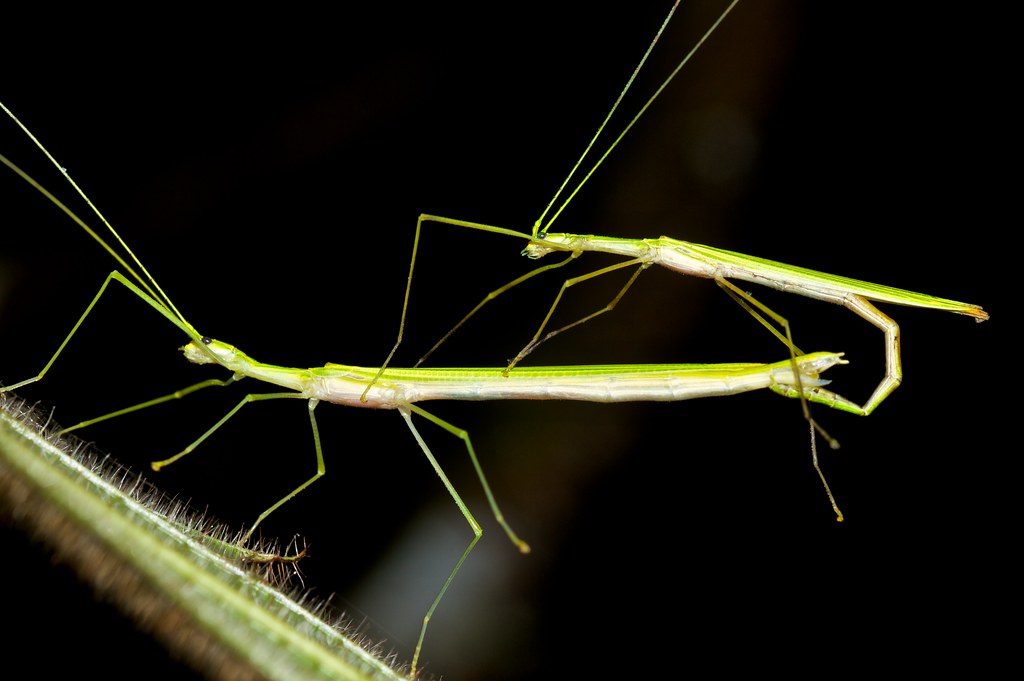As its name suggests, the stick insect resembles the twigs among which it lives, providing it with one of the most efficient natural camouflages on Earth. It and the equally inconspicuous leaf insect comprise the Phasmatodea order, of which there are approximately 3,000 species. They are also known as stick-bug, phasmid, leaf insect, bug insect and walking stick etc.
The one that most people are familiar with is the Praying Mantis. Some of them look like leaves too and not just sticks. Stick insects can be found all over the world except for the Antarctica and Patagonia.
The average life span of a Stick Insect is about 1-2 years but some have been known to live longer.

Description Of The Stick Insect
They generally mimic their surroundings in color, normally green or brown, although some species are brilliantly colored and others conspicuously striped. Many stick insects have wings, some spectacularly beautiful, while others resemble little more than a stump. A number of species have spines and tubercles on their bodies. Stick Insects tend to have long, thin bodies with small heads. They don’t have wings most of the time. Some species do have very small wings though. Their overall shape, size, and coloring can vary depending on the specific species. Some of them are only about a1 inch long and others can be up to1 foot long.
All species of Stick Insects feature compound eyes. This allows them to see what is going on around in them in all types of conditions, even dim lighting areas. As a result they have a better chance of being able to stay safe and to avoid predators. Most Stick Insects are nocturnal so they are active at night and able to see well during that period of time.
Habitat Of The Stick Insect
They can be found mostly in the tropics and subtropics—although several species live in temperate regions—stick insects thrive in forests and grasslands, where they feed on leaves. Mainly nocturnal creatures, they spend much of their day motionless, hidden under plants.
Behavior Of The Stick Insect
Some of them have the ability to change the pigment of their bodies to match their surroundings. They also move side to side so that when they are moving it resembles the natural movements of leaves, twigs, and other elements in nature. This rocking type of movement is very rhythmic.
Diet Of The Stick Insect
Stick Insects are herbivores and they feed on a variety of plants, leaves, and shrubs. They actually play a very important role in the balance of ecosystems due to what they consume. They will eat dead foliage too and that leaves areas open for new growth that all living things in that environment are able to benefit from.
Reproduction Of The Stick Insect
The mating times will vary for the different species of Stick Insects. Some species allow for the females to deposit eggs and then to have a male deposit sperm on them. No interaction ever occurs. For other species though there are various rituals for mating and the males may be aggressively fighting each other for the right to mate.
Once conception has occurred, the female can lay between 100 and 1,200 eggs. She will deposit them in a well hidden location in leaves and other areas to keep them safe from predators. It can take from 13 days to over 70 days before eggs hatch, depending on species.
12 Interesting Facts About Stick Insects
- As part of their camouflage, stick insects have fake buds and leaf scars
- The name of the phasmatodea order is greek for “apparition”.
- They Can Regenerate Shed Limbs – Should a bird or other predator grab hold of its leg, a stick insect can still make an easy escape. The imperiled insect simply gives up the leg, using a special muscle to break it off at a weak joint. This defensive strategy is known as autotomy. Juvenile stick insects will regenerate the missing limb the next time they molt. In some cases, adult stick insects can even force themselves to molt again to regain a lost leg.
- Stick Insects Reproduce Without Males – Stick insects are a nation of Amazonians, able to reproduce almost entirely without males, or parthenogenetically. Unmated females produce eggs that become more females. When a male does manage to mate with a female, there’s a 50/50 chance their offspring will be male. A captive female stick insect can produce hundreds of all-female offspring without ever mating. In fact, there are species of stick insects for which scientists have never found any males.
- Stick Insects Even Act Like Sticks – Stick insects are so named for their effective camouflage among the woody plants where they feed. They’re typically brown, black, or green, with stick-shaped bodies that help them blend in as they perch on twigs and branches. Some exhibit lichen-like markings to make their disguise more authentic. But here’s the capper: Stick insects even imitate twigs swaying in the wind by rocking back and forth as they move.
- Their Eggs Resemble Seeds – Stick insect mothers aren’t the most maternal. They typically drop eggs randomly on the forest floor, leaving the youngsters to whatever fate befalls them. Don’t be so quick to judge mama stick insect, though. By spreading her eggs out, she lessens the chance that a predator will find all her offspring and eat them all. The eggs resemble seeds, so carnivorous predators are less likely to take a closer look. Some stick insects actually make an effort to hide their eggs, sticking them to leaves or bark or placing them in the soil.
- Nymphs Eat Their Molted Skin – After a nymph has molted, it’s vulnerable to predators until its new cuticle darkens and hardens. The castoff skin nearby is a dead giveaway to enemies, so the nymph quickly consumes the shriveled exoskeleton to get rid of the evidence. The stick insect nymph also recycles the protein by eating its molted skin. It took a lot of energy to grow that exoskeleton, so there’s no sense in letting it go to waste.
- Stick Insects Aren’t Defenseless – Stick insects aren’t venomous, but if threatened, one will use whatever means necessary to thwart its attacker. Some will regurgitate a nasty substance that will put a bad taste in a hungry predator’s mouth. Others reflex bleed, oozing a foul-smelling hemolymph from joints in their body. Some of the large, tropical stick insects may use their leg spines, which help them climb, to inflict some pain on an enemy. Stick insects may even direct a chemical spray, much like tear gas, at the offender.
- Their Eggs May Attract Ants – Stick insect eggs that resemble hard seeds have a special, fatty capsule called a capitulum at one end. Ants enjoy the nutritional boost provided by the capitulum and carry the stick insect eggs back to their nests for a meal. After the ants feed on the fats and nutrients, they toss the eggs onto their garbage heap, where the eggs continue to incubate, safe from predators. As the nymphs hatch, they make their way out of the ant nest.
- Not All Stick Insects Stay Brown – Some stick insects can change color, like a chameleon, depending on the background where they’re at rest. Stick insects may also wear bright colors on their wings but keep these flamboyant features tucked away. When a bird or other predator approaches, the stick insect will flash the vibrant wings, then hide them again, leaving the predator confused and unable to relocate its target.
- Stick Insects Can Play Dead – When all else fails, play dead, right? A threatened stick insect will abruptly drop from wherever it’s perched, fall to the ground, and stay very still. This behavior, called thanatosis, can successfully discourage predators. A bird or mouse may be unable to find the immobile insect on the ground or prefer living prey and move on.
- Stick Insects Are the World’s Longest – In 2008, a newly discovered stick insect species from Borneo broke the record for longest insect (which had previously been held by another stick insect, Pharnacia serratipes). The Chan’s megastick, Phobaeticus chani, measures an incredible 22 inches with legs extended, with a body length of 14 inches.
About Stick Insects
Stick Insects can be found all over the world except for Antarctic and Patagonia. They mimic their surroundings in colour etc. They spend much of their day motionless, hidden under plants. They feed on a variety of plants, leaves and shrubs. This intriguing and fascinating insect can be found throughout Guyana.
Article References:
- https://www.thoughtco.com/fascinating-facts-about-stick-insects-1968575
- https://en.wikipedia.org/wiki/Phasmatodea
- https://easyscienceforkids.com/stick-insect/
- https://www.nationalgeographic.com/animals/invertebrates/group/stick-insects/







